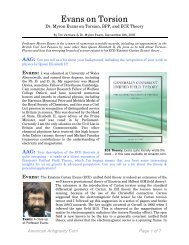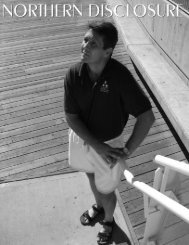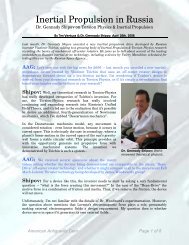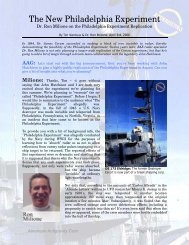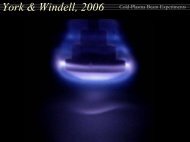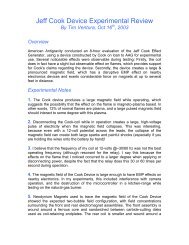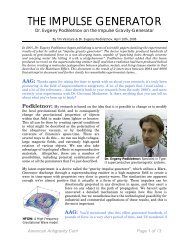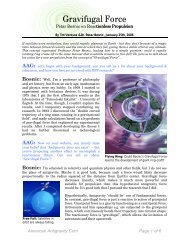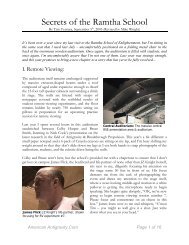Paul-Czysz-Hypersoni.. - American Antigravity
Paul-Czysz-Hypersoni.. - American Antigravity
Paul-Czysz-Hypersoni.. - American Antigravity
You also want an ePaper? Increase the reach of your titles
YUMPU automatically turns print PDFs into web optimized ePapers that Google loves.
<strong>American</strong> <strong>Antigravity</strong>.Com Page 1 of 13
AURORA & BEYOND<br />
<strong>Paul</strong> <strong>Czysz</strong> on <strong>Hypersoni</strong>c Aircraft<br />
By Tim Ventura & <strong>Paul</strong> <strong>Czysz</strong>, July 26th, 2006<br />
It’s a name that evokes awe in the aerospace<br />
industry – Aurora, a Mach-6 hypersonic aircraft<br />
that nobody’s sure exists. We join hypersonic<br />
pioneer <strong>Paul</strong> Czsyz for the inside scoop on Aurora<br />
and a next-generation Mach-15 successor that<br />
may be capable of even reaching space…<br />
AAG: Two weeks ago, an Air Force officer<br />
told me that a colleague of his paid a visit to<br />
one of the big R&D test-bases in the early 90’s<br />
and saw a high-dollar budget item for<br />
“Aurora” on a financial report. He thinks that<br />
this Mach-6 hypersonic aircraft exists, but he<br />
isn’t sure – what do you think?<br />
<strong>Czysz</strong>: It could exist. There’s no magic<br />
required to build it. I was convinced that the<br />
group I was with at McDonnell-Douglas in<br />
the mid-60’s could have built it back then.<br />
We built two hypersonic aircraft models for<br />
Mel Buck over at Wright-Patterson that we<br />
tested for pressure measurements, force<br />
measurements, and thermal mapping to get<br />
the heat-transfer rates. Those models went in<br />
every tunnel we could find – from the lowspeed<br />
tunnels all the way up to the Mach-6<br />
and 8 tunnels. We had over 1,300 hours of<br />
wind-tunnel test-time on those models…<br />
AAG: So at least technically, Aurora could<br />
be part of our military arsenal, then. Have<br />
you ever seen any evidence that aircraft like<br />
this might really be in service today?<br />
<strong>Czysz</strong>: If they were built, and that’s the<br />
big question. I’ve had strange calls in the<br />
evening by people who were telling me, “I<br />
used to work with you, and I’m standing next<br />
to the aircraft that you’d recognize”, and then<br />
they hung up. I think the rumor mill is<br />
probably right about Aurora.<br />
<strong>American</strong> <strong>Antigravity</strong>.Com Page 2 of 13
<strong>Paul</strong> Czsyz at STAIF 2006<br />
AAG: Those strange calls make sense,<br />
though, in the context of your remarkable<br />
background in hypersonic aerospace<br />
engineering, culminating in your role as the<br />
chief scientist for the National Aerospace<br />
Plane project, touted by Reagan as the<br />
successor to the Space-Shuttle after the<br />
Challenger tragedy in 1986.<br />
<strong>Czysz</strong>: Well, I started out at Wright-<br />
Patterson in 1958, but when Sputnik went up<br />
we were all re-assigned: in my case, to a hightemperature<br />
hypersonic wind-tunnel, working<br />
with the people from the Flight Dynamics Lab.<br />
Mel Buck was one of the fellows in charge of<br />
the aircraft side of things, and Dick Newman<br />
and Al Draper were on the hypersonic-glider<br />
side, working on the type of vehicles we call<br />
spacecraft today.<br />
When I left in ’63 and went to work for<br />
McDonnell Aircraft Company, one of the first<br />
things that I got involved with was their<br />
hypersonic impulse tunnel, and we were doing<br />
some Mach 12 testing of one of the vehicles I<br />
was working on at Wright-Field.<br />
In ’66 I joined the advanced design group over<br />
at McDonnell, and one of the projects that I<br />
was working on was a Mach 6 hypersonic<br />
vehicle that would fly unrefueled in a combat<br />
situation about 1,500 nautical miles, with<br />
about a 4,000 nautical mile overall range.<br />
There were a couple of different versions of it<br />
– one was to shoot down submarine launched<br />
ballistic missiles launched off the coast of the<br />
United States, and the other one was<br />
essentially to interdict soviet ships that were<br />
coming through the GIUK gap.<br />
If you launch a Mach 6 interceptor out of<br />
something like the New York area, by the time<br />
it gets to the GIUK gap, even the fastest soviet<br />
ships could not have moved more than about<br />
10 miles. So using the last known position of<br />
the ship provided by even simple radar<br />
contact, the aircraft can pull a 3.5 gee turn, it<br />
can fly a circle around the last known contact<br />
point to find the ship that it’s looking for.<br />
<strong>American</strong> <strong>Antigravity</strong>.Com Page 3 of 13
That’s not a difficult maneuver for this aircraft – in fact, a Mach 6 interceptor burns less fuel in a<br />
3.5 gee turn than the F-15 does at full-afterburner. So you’ve an aircraft that can rapidly reach<br />
the ship’s last known location and fly a circle around the last known contact point – whether or<br />
not ship has changed direction, it’s still going to be inside that search radius, making this a<br />
highly effectively quick-response weapon.<br />
AAG: Well in terms of the hypersonic concept,<br />
I’m wondering if this originated out of the need to<br />
outrun enemy missiles. Apparently the strategy of<br />
the U-2 was simply to fly higher, and I’m<br />
wondering if Aurora is attempting to fly faster as<br />
another solution to the problem?<br />
<strong>Czysz</strong>: It’s not about outrunning missiles – it’s<br />
about response time. In other words, at flank<br />
speed, a cruiser like the Kirov can run at about 32<br />
knots, which is 32 nautical miles per hour. The<br />
horizon for a ship is about 6 miles away, so you<br />
have to be up in an aircraft to see it – so if you’re<br />
going to detect it, you have to get there before the<br />
ship travels too far.<br />
Aurora: An artist’s rendering of the secret<br />
Mach 6 to 8 aircraft flown out of Area 51.<br />
AAG: In other words, you have an increasing radius for the ship’s probable location, and if<br />
you have a response time that might be 4 to 6 hours to reach the last known contact point, it<br />
becomes that much harder to find it.<br />
<strong>Czysz</strong>: Yes, with a slow response time, you’ll never find it – the ship will be completely out<br />
of your search range. However, if you can get there in 45 minutes or an hour and a half, then the<br />
ship will still be inside the circle that you fly around its last known position.<br />
Now the other application for this Mach 6 aircraft is intercepting ballistic missiles. If a<br />
submarine pops up just off the coast and launches a ballistic missile, if you have a the right kind<br />
of Mach 6 aircraft with a good hypersonic kill missile, then you can still hit that ballistic missile<br />
while it’s climbing, so you can use it to help protect the United States from nuclear attack.<br />
There were a whole bunch of applications – these were powered by air-turbo ramjets, both Pratt<br />
& GE designs – we had vehicles that went all the way from a Mach 4 deck-launched interceptor<br />
for the Navy to vehicles that went all the way up to Mach 12. These ended up in a study for NASA<br />
called the “<strong>Hypersoni</strong>c Research Facilities Study”,<br />
which essentially was a comparison between<br />
ground-test facilities and flight-test facilities to see<br />
which ones give you the most information to build<br />
an operational high-speed aircraft. The flight-test<br />
vehicle won hands-down, because the ground-test<br />
facilities were so expensive, and they could only<br />
work on a fraction of the problem.<br />
Blended Body: In a hypersonic vehicle, the<br />
bottom of the aircraft is basically the engine.<br />
AAG: Out of curiousity, in terms of actual,<br />
tested aircraft, what’s the fastest speed that they’ve<br />
ever gotten a hypersonic aircraft up to?<br />
<strong>American</strong> <strong>Antigravity</strong>.Com Page 4 of 13
<strong>Czysz</strong>: We don’t know, because at least publicly we never completed the hypersonic facilities<br />
study – but there were programs in existence inside the classified community that may have<br />
taken the research farther than we did. The X-7, which was a Lockheed scramjet research vehicle<br />
that recovered itself with a long spike sticking in the sand over in the desert supposedly<br />
exceeded Mach 7 or 8.<br />
My group actually tested engines in aircraft past Mach 12 – we had data on some of our<br />
hypersonic glide vehicles when the tunnels were still operating all the way to Mach 20 or 22<br />
down in Tullahoma.<br />
AAG: Now you’ve talked about losing<br />
test-pilots during this process also, right? I<br />
remember you saying something about the<br />
aerodynamics being very counterintuitive at<br />
hypersonic speeds...<br />
<strong>Czysz</strong>: No, no – we didn’t actually lose<br />
test-pilots – I was referring to the<br />
aerodynamics during training in a<br />
hypersonic flight simulator. The bottom of<br />
the aircraft in a Mach 8 to 12 scramjet is the<br />
engine. Now the way you get an engine to<br />
put out more thrust is to increase the<br />
capture area of the engine – that’s how you<br />
get the variable capture inlet area on the F-<br />
15 – you can control the thrust level<br />
potential by controlling the airflow to the<br />
engine. So if you have a scramjet vehicle,<br />
and you want to increase the thrust of it,<br />
you have to increase it’s angle of attack –<br />
not by much, only by about 2 or 3 degrees.<br />
Nevertheless, as you advance the throttle,<br />
the nose comes up, and that’s very<br />
counterintuitive to a pilot, who will think<br />
that the nose coming up when you advance<br />
the throttle means that there’s something<br />
wrong.<br />
<strong>Hypersoni</strong>cs: Designs for Mach 4.5 & 6 vehicles<br />
designed by McDonnell-Douglas from ’58 to ’64.<br />
So in the simulator, these pilots were not pulling up, but they were advancing the throttle.<br />
Again, in order to get more thrust out of a ram-compression engine you have to increase the<br />
capture area, and the way that you increase the capture area is to pull the nose up – and since<br />
the whole bottom of the aircraft is the engine, it increases its capture area.<br />
AAG: Most people probably weren’t really aware of the rumors about Aurora until Bill<br />
Sweetman’s Popular Science article about it in 1993. Now in that article, they discussed a “string<br />
of pearls” UFO reported traveling westerly over northern California, followed moments later by<br />
the same traveling back over SoCal –which enthusiasts took to be evidence of an external-burn<br />
engine they thought proved Aurora’s existence.<br />
<strong>Czysz</strong>: “Donuts on a chain” is actually the common term – but this stuff goes back a lot<br />
further than those UFO’s reports that Sweetman was talking about – the aircraft that we were<br />
<strong>American</strong> <strong>Antigravity</strong>.Com Page 5 of 13
involved with go back at least to ’64 or ’65, and I was convinced while I was with the Advanced<br />
Design Group over at McDonnell in the mid 60’s that we could have built one of these.. It<br />
wouldn’t have even been a challenge.<br />
All of this “donuts on a chain stuff” is pretty basic – if you’ve ever watched when Fred Billick<br />
used to run his scramjets up a John’s Hopkins you’d get a really good visual of what’s going on<br />
here. There’s no such thing as an absolutely steady shock-compression engine. Little changes in<br />
the atmosphere and other variables cause the shockwave to move back and forth inside the<br />
engine, which changes the compression slightly. This causes the exhaust-glow to pulsate – what<br />
that means to me is that it’s an engine like Fred used to build. There’s no magic to it.<br />
AAG: Now would a hypersonic aircraft like this be much larger or heavier than a<br />
conventional fighter interceptor?<br />
<strong>Czysz</strong>: Our Mach 6 interceptors weren’t<br />
built like the X-15 prototype, which used a<br />
steel-alloy hot-structure that served as a heatsink<br />
for aerodynamic heat-loads. Ours were<br />
built with metal thermal protection-systems<br />
over a lightweight aluminum structure, so<br />
most of the thermal energy was radiated away<br />
into space, and for those vehicles we were<br />
running somewhere around the weight of a<br />
DC-9. These were neither exceptionally large<br />
nor heavy vehicles – they were somewhere on<br />
the order of 60 to 70 feet long. That was for a<br />
single person combat vehicle – now for a<br />
multi-crewed, very long-range vehicle, you<br />
might start looking at something with a size<br />
and weight comparable to a 747.<br />
Heat-Proof: A roll-bonded titanium structural<br />
component used in the McDonnell prototype.<br />
AAG: Well, wasn’t the larger vehicle design closer to the goals of the National Aerospace<br />
Plane (NASP) project that you worked on later in the 1980’s, for hypersonic passenger & cargo<br />
transport?<br />
<strong>Czysz</strong>: Well, it’s hard to say what NASP was aimed at. Between about ’76 and ’83, I was<br />
involved with some special programs at McDonnell. On the last day in July in 1983, I was out<br />
there on Thursday and I was supposed to leave the next morning to be home for the weekend.<br />
Anyhow, I got a call from one of the Directors who said, “I happen to be out here for something<br />
– you’re not going home yet, you’re going to meet me at the Air Force station tomorrow for<br />
lunch over by the Aerospace Corporation on Sepulveda. Maybe you’ll make it home by Monday<br />
– we’ll see.”<br />
So I show up for lunch over at the Air Force station, and Harold Ostroff was sitting down at this<br />
table with a big group of military & civilian guys in business suits, and as I walked up to the<br />
table, he turns to the other guys sitting there and says, “I’d like to introduce you all to the new<br />
head of McDonnell’s Advanced Aerospace Program.” Anyhow, I didn’t know anything about this<br />
beforehand, and when he said it I looked around a bit for the person he was talking about – and<br />
after a second I guess that it finally sunk in that he was talking about me.<br />
<strong>American</strong> <strong>Antigravity</strong>.Com Page 6 of 13
So that was how I found out about it – I had<br />
a deputy program manager from<br />
Huntington Beach, and there was a group<br />
there from Aerojet -- Don Kissinger, Mike<br />
Hamel, and Ron Samborski – that were<br />
there to talk about the air-turbo ramjet<br />
work that they’d patented back in 1946.<br />
I went out to Aerojet the next couple of days<br />
for briefings on their engine designs, and<br />
when I came back home, we did a proposal<br />
for the Air Force TAV program, but the<br />
main thrust was a proposal that we put<br />
together with the people from Huntington<br />
Beach on a 2-stage to orbit vehicle. The first<br />
stage would fly with air-turbo ramjets to<br />
about Mach 6 or 7, and then it would stage<br />
with a scramjet vehicle a rocket that would<br />
deploy up into orbit.<br />
We had several different concepts for this,<br />
depending on how soon we wanted we<br />
wanted the thing to fly. One of the people<br />
out at Huntington Beach named Joe Shergi<br />
had a concept for what he called a “tossback<br />
booster”, that looked like an Apollo<br />
capsule with engines mounted in what<br />
looked like the heat-shield. After you<br />
separated the upper-stage, this thing would<br />
turn around and retrofire to toss back to the<br />
launch site, making everything recoverable.<br />
We had 2 or 3 concepts that we were<br />
briefing as 2-stage to orbit vehicles. The first<br />
one that we could build quickly, based on all<br />
the hardware that was available, was a<br />
hypersonic FDL-7C glider on top of a tossback<br />
booster. Then we went to an air-turbo<br />
ramjet first stage which went to about Mach<br />
7 to 8, and later we went to a scramjet first<br />
stage that went to about Mach 12.<br />
We hired a guy named Larry Fogel from the<br />
Titan Corporation, and he actually toured<br />
all of the SAC bases that had operational B-<br />
52 squadrons and asked them what they<br />
would do if they had one of these NASP<br />
vehicles -- how they use it, maintain it, and<br />
stuff like that. We built an entire database<br />
on what the Strategic Air Command<br />
estimated these vehicles would cost to<br />
operate. We’d given them all the numbers<br />
that we had at the outset – how much thrust<br />
we had, how much propellant we needed,<br />
NASP and the X-30: The X-30 National<br />
Aerospace Plane (NASP) was the public follow-on<br />
to the classified Defense Advanced Research<br />
Projects Agency (DARPA) Copper Canyon program<br />
of 1982-1985.<br />
President Reagan announced the NASP project in<br />
his 1986 State of the Union message, calling for<br />
development of "...a new Orient Express that<br />
could, by the end of the next decade, take off from<br />
Dulles Airport and accelerate up to twenty-five<br />
times the speed of sound, attaining low earth orbit<br />
or flying to Tokyo within two hours...".<br />
This program to develop an single-stage-to-orbit,<br />
horizontal takeoff/horizontal landing, air-breathing<br />
scramjet manned vehicle started at Phase 2<br />
(Copper Canyon was Phase 1). In this phase the<br />
essential new materials, structures, and<br />
manufacturing processes would be validated.<br />
Phase 3, the actual design, construction and flight<br />
testing of the aircraft, was to begin in 1990.<br />
The Department of Defense was to fund $2.65 of<br />
the $3.33 billion Phase 2 development cost over<br />
eight years. It was never made quite clear what<br />
the Defense Department's interest in the project<br />
was. Many observers believed that it was all an<br />
elaborate cover for development of one or more<br />
heavily-classified high-technology vehicles.<br />
- Mark Wade, Astronautix.Com<br />
<strong>American</strong> <strong>Antigravity</strong>.Com Page 7 of 13
how many times the engines could be re-used, etc – and they gave us back operational cost<br />
estimates compared to a traditional B-52 squadron. It was quite interesting…<br />
We took this information and used it for briefings in Washington DC, which is where I met<br />
Scotty Crossfield, who was working with Dan Glickman – and what we ended up with was the<br />
first stage vehicle, which was a large, Mach-6 vehicle. This led to the development of a prototype<br />
that we created as a demonstrator to validate the technology.<br />
So the prototype was built to show how the NASP vehicle could fulfill 3 primary mission roles.<br />
The first was simply as a Mach-6 transport for passengers, the second was a Mach-8 strategic<br />
strike-aircraft for the Air Force, and the third involved combining the vehicle with an upperstage<br />
rocket to go into Low-Earth Orbit.<br />
AAG: It sounds like this technology really blurs the line between an aircraft and the Space-<br />
Shuttle or maybe even a true spacecraft...<br />
<strong>Czysz</strong>: Well the shuttle’s not an aircraft – it’s an abortion trying to figure out how to fly. You<br />
never want to build a vehicle that looks like that.<br />
The best vehicles ever designed came out of the Air<br />
Force Flight-Dynamics Lab, and Draper made one<br />
huge effort to try and get NASA to listen, and they<br />
absolutely refused to take his advice.<br />
From the beginning, NASA had their own ideas<br />
about bluntness and all sorts of crazy design ideas<br />
that ended up in the Shuttle. The real hypersonic<br />
vehicles that were inherently stable – from Mach<br />
22 all the way down to zero, and had thermal<br />
protection systems already worked out – were<br />
simply discarded.<br />
These weren’t new ideas, even when the Shuttle<br />
was being designed. The Department of Defense<br />
was involved with this between ’58 and ’68, and<br />
they were discarded because the President at that<br />
time decided that no military systems would enter<br />
orbit. The administration was deathly afraid back<br />
then of militarizing space, which meant that<br />
everything going into space had to be civilian, so<br />
NASA took over everything.<br />
Goodbye Shuttle: If NASP had been<br />
completed, it would have replaced Shuttle.<br />
The Air Force has something called the XLR-129 – it’s in a book that one of the Pratt & Whitney<br />
guys wrote that you can buy from the Society of Automotive Engineers library. The XLR-129 had<br />
about 580,000 pounds of thrust from a LOX-hydrogen engine and 3,500 psi chamber pressure.<br />
It was fired 40 times without any overhaul, and it was brought up to full-power in about 3.5<br />
months – whereas the Space Shuttle Main Engine (SSME) took about 38 months to come up to<br />
full-power.<br />
This very same XLR-129 engine was donated to NASA when the Air Force got out of the spacerace.<br />
The plans, the engine, and everything related to it were destroyed, and the last sentence in<br />
that chapter in Pratt’s book says, “NASA destroyed all of this because they didn’t want to<br />
embarrass their present engine contractor.”<br />
<strong>American</strong> <strong>Antigravity</strong>.Com Page 8 of 13
AAG: Let’s return to Aurora for a bit – given what you’ve said about the later goals of the<br />
NASP project, do you think that one of Aurora’s mission roles might be some kind of satellitedeployment<br />
and retrieval system for the Air Force?<br />
<strong>Czysz</strong>: No – that’s not possible with Aurora. You can’t build a Mach-6 aircraft that goes to<br />
orbit. You can build a first-stage to reach Mach-6 and then launch off the top of it to reach orbit<br />
– that’s the Sanger concept that MBB had. However, Aurora itself is an aircraft, not a spacecraft.<br />
It’s going to be focused on the primary mission roles that I described earlier, like the naval<br />
interdiction role that we talked about.<br />
AAG: Well, given the issues that NASA’s having with the Shuttle Program at the moment, do<br />
you think that they may someday return to this type of hardware for a next-generation Shuttle<br />
design?<br />
<strong>Czysz</strong>: One of Reagan’s assistant secretaries of commerce – for innovation, technology, and<br />
productivity-- was named D. Bruce Merrifield, and he was very Russian in his thinking. The<br />
Russians have prototype factories that take laboratory ideas, and translate them into something<br />
that can be used in a functional, operational piece of hardware.<br />
Merrifield’s concept was that the deficiency in the<br />
United States is that it uses projects to prepare<br />
technologies for application, which doesn’t give the<br />
new technologies adequate time to properly<br />
mature. He always advocated that just like with<br />
baseball players, technology needs a “farm team” to<br />
develop it so that it can later be used functionally.<br />
The Japanese do this, the Russians used to do this,<br />
and they do it because it produces great results.<br />
What we were doing when I was at McDonnell-<br />
Douglas – because “Old-Man Mac” was a hardware<br />
guy – was looking at how you could take these big<br />
ideas and build samples & prototypes out of them,<br />
to see if we could come out of this with an<br />
operational concept.<br />
When we designed a Mach-6 aircraft, we didn’t<br />
follow NASA’s strategy of building a research and<br />
develop vehicle that could only be flown 3 times a<br />
year. What we developed were vehicles that were<br />
operationally functional as much as a B-52 is.<br />
Wind-Tunnel: Testing of a NASP model in a<br />
Mach-12+ wind-tunnel at NASA.<br />
Our resupply vehicle in 1964 for the manned orbiting laboratory had 11 operational vehicles and<br />
3 spares – and those 11 vehicles flew 100 times a year for 15 years. That’s 1964 industrial<br />
capability – no magic at all. I don’t need magic. Now compare that to the Shuttle.<br />
AAG: The amazing thing from my perspective is learning about just how much has already<br />
been accomplished in this area, and in the area of hypersonics. In 2006 we’re back to<br />
questioning what we can achieve, and most of the questions are about things that have already<br />
been achieved – the scope of prior work is just amazing...<br />
<strong>American</strong> <strong>Antigravity</strong>.Com Page 9 of 13
<strong>Czysz</strong>: Yes, we accomplished a lot. You know, the other problem is that if you get<br />
organization who’s function is research and development, and you hand them an operational<br />
vehicle, they don’t want it, because they want to do research and development.<br />
AAG: Well again, the NASP design is a really beautiful design – it’s really remarkable as<br />
being an evolution of the lifting body. It’s what the Shuttle could have, and probably should have<br />
been, right?<br />
<strong>Czysz</strong>: The baseline vehicle that was used as the reference vehicle for NASP was the original<br />
1963 Mach-12 scramjet powered vehicle by McDonnell. I’m putting together some of our older<br />
materials that you can post on the website – including stuff back to ’58. When you at the old<br />
Mach-6 aircraft, you’ll look at it and immediately say it’s Aurora, but it’s not – it was called our<br />
Mach 6 manned hypersonic fighter.<br />
AAG: One thing I’d wondered about from<br />
some of the NASP schematics I’ve seen is the<br />
blunt nose – why is that?<br />
<strong>Czysz</strong>: Not blunt – 2 dimensional. It’s got<br />
a sharp wedge at the nose. Now the original<br />
hypersonic vehicle for McDonnell-Douglas<br />
had a pointed nose – it was based on a conicle<br />
body. It was a lifting body, but it had a<br />
pointed nose. Back in those days the low-drag<br />
vehicles were all pointed cones.<br />
However, if you go into any reference book<br />
and you look up the wave drag of a pointed<br />
cone versus a sharp-wedge, the wedge has the<br />
square root of 3 over 3 of the pointed cone.<br />
The 2-dimensional wedge at the same angle<br />
has less drag than the cone does.<br />
<strong>Hypersoni</strong>c Airflow: A CAD-rendering of the<br />
NASP vehicle’s hypersonic airflow during flight.<br />
So Dick Newman over at flight dynamics lab at about ’59 and 60 with Will Hankey, Jack Pike<br />
over in England, and Bob Kreger who’s a VP over at Boeing now came up with a 2-dimensional<br />
nose. You look at it from the side and it looks like a point, and you look at it from the top and it<br />
looks blunt. It’s not a blunt nose, though – it’s a 2-dimensional nose. It’s a wedge.<br />
The whole idea here is having less drag. You want the least drag you can get – especially for an<br />
air-breather. You can argue whether it’s a straight across the top or it’s a power-law – we’ve had<br />
all different kinds depending on whose theory we were operating on. But it’s still a 2-<br />
dimensional nose.<br />
AAG: Now in terms of hypersonic aircraft, do you think we’ll ever see something like this<br />
become a recognized part of our arsenal and a larger component of future air-power? It seems<br />
like there’s always a need for faster aircraft, and but today’s state of the art seems to be going in<br />
a different direction…<br />
<strong>Czysz</strong>: Well when Scott Crossfield, Gus Wyss, and myself were sitting over at the aerospace<br />
club in Washington DC, we put together a chart for Sandy McDonnell that talked about the<br />
<strong>American</strong> <strong>Antigravity</strong>.Com Page 10 of 13
demonstator that we were proposing for the Air Force – this came well before Copper Canyon<br />
ever started. Now at Mach 6, it could carry about 40 people, a Mach 7 capability to carry military<br />
goods, and it could be used as a demonstrator to show that with the right equipment – a rocket<br />
boost inside of it plus the air-breathing engine – we could get it to orbital speed.<br />
Now we weren’t going to take it into orbit – we were going to take it up to nearly orbital speed<br />
and then glide around back on the other side. So a full-sized version of this would fly at Mach 4.5<br />
across the Pacific. So we were sitting there talking about what this concept, and that’s when<br />
Scotty came up with the name “Orient Express”….so that’s where that name originally came<br />
from.<br />
If you go back and look at the original B-70<br />
proposals, one of concepts was proposed was<br />
to take the fuel out of the fuselage as a<br />
demonstrator to show that a Mach-3<br />
transport could carry commercial passengers<br />
without killing them. If you take the hydrogen<br />
tank and block it off so you can fly with<br />
methane instead as an aerodynamic vehicle,<br />
then you have enough space in the tank for<br />
about 40 or 50 people. Since the tank was<br />
built to keep liquid hydrogen cold, keeping<br />
the people warm to 72 degrees wasn’t even an<br />
issue. You see, the critics kept telling us, “the<br />
people are going to burn up”, but that’s not<br />
true – why would they burn up? They’re<br />
sitting inside of a tank designed to hold -450<br />
degree hydrogen.<br />
Orient Express: Attaining low-earth orbit or flying<br />
to Tokyo in 2 hours, according to President Reagan<br />
AAG: So you’re talking about Mach 3 commercial transportation in your vehicle, then? What<br />
kind of coast to coast flight-times are you going to get with something like that?<br />
<strong>Czysz</strong>: No – the B-70 project was Mach 3.2, and ours was Mach 4.5. Same idea, though. The<br />
Coast to Coast times you’re talking about are too short – it takes you a certain length of time to<br />
climb and a certain length of time to descend.<br />
Let’s use an extreme example: let’s say that you’re going to fly at Mach 12. The shortest possible<br />
distance that makes it possible is about 5,000 miles. For something like Mach 2.5, then<br />
something like 2,500 miles might be practical. I don’t have the graph any longer, but the idea is<br />
that for each distance there is a speed that gives you the least time – if you fly faster or slower<br />
than that, it’s going to take longer.<br />
AAG: That basically involves climbing, accelerating, and getting to the right altitude, right?<br />
<strong>Czysz</strong>: The hard part is slowing down – because if you have air-shocks in the inlet from<br />
slowing down too fast, you’ll unstart the engine. So it takes you twice as long to slow down as it<br />
does for you to accelerate.<br />
AAG: Now in terms of maneuverability for a hypersonic aircraft, is it pretty maneuverable,<br />
or is the aircraft just flying too fast to maneuver well?<br />
<strong>American</strong> <strong>Antigravity</strong>.Com Page 11 of 13
<strong>Czysz</strong>: It’s maneuverable – you can pull load-factor with that. With our Mach-6 strike<br />
reconnaissance craft flying over the GIUK gap, we could pull a 3.5 gee turn with no difficulty. It<br />
gets harder the faster you go, because the angle of attack increases the temperature, so you have<br />
to be very careful – but at Mach 6 it’s no problem.<br />
AAG: The reason I asked is because there was<br />
speculation in the Popular Science article on<br />
Aurora that the vehicle was taking the length of the<br />
entire state of California to turn around. That’s why<br />
the “UFO” was supposedly heading westerly over<br />
San Francisco and seen returning over San Diego, if<br />
I remember correctly…<br />
<strong>Czysz</strong>: At Mach 12 maybe, but not Mach 6. If<br />
you were flying over a spot in the GIUK gap at<br />
Mach 6, you could do a 150 or 200 mile diameter<br />
turn – which is perfect for interdiction, because you<br />
wanted the ship or whatever you were tracking to<br />
be inside the turn. So as you banked up to do the<br />
turn, your sensors would be pointing right straight<br />
down at the ground.<br />
Interdiction: Flying a pattern at Mach 6 to<br />
locate potentially hostile naval vessels.<br />
AAG: Did you guys ever look at deploying weapons out of a hypersonic aircraft? Would there<br />
be any problems with that?<br />
<strong>Czysz</strong>: Naw…they used to bet Kelly Johnson that he could never deploy all kinds of stuff out<br />
of the YF-12, but he designed his own system and deployed 6-missiles out of the YF-12 with no<br />
problems at all. I have never met a group of aerospace engineers or aeronautical engineers like<br />
that group of people. The mold for them is gone - people don’t think like that anymore. They<br />
were problem solvers.<br />
They did a lot of pioneering work with beta-titanium, and it’s very hard stuff to work with. When<br />
Kelly first started making structural components out of this material, out of the first hundred<br />
forgings that he performed, he had 1 component that worked—the rest were garbage. Three<br />
months later, out of the 100 parts that he tried, he got 94 out<br />
that worked. He didn’t bring in outside specialists or<br />
contractors to solve the problem – it was his own team that<br />
came up with the solution. When you actually tell people<br />
some of the experiences they had on the SR-71 Project, in<br />
today’s environment it would be cancelled.<br />
Kelly Johnson: Founder of the<br />
Lockheed Skunkworks division.<br />
AAG: Those are impressive colleagues – it’s no wonder<br />
you were getting late-night calls from people standing next to<br />
“an aircraft you’d recognize”. Did you ever follow up later<br />
with any of them to see if they’d be more open to discussing<br />
it now that they’re retired?<br />
<strong>Czysz</strong>: No, the ones that I knew who were involved are<br />
no longer alive, and the ones who are involved today don’t<br />
talk.<br />
<strong>American</strong> <strong>Antigravity</strong>.Com Page 12 of 13
AAG: Do you think that’s because these<br />
projects are still ongoing, and anybody who<br />
knows about them is bound by a secrecy<br />
agreements?<br />
<strong>Czysz</strong>: Well, remember, there’s a whole<br />
new young generation of engineers designing<br />
today’s aircraft. If these aircraft exist, it’s like<br />
the how the B-52 pilots of today are the<br />
grandsons of the ones who started flying B-<br />
52’s when they were first introduced – so<br />
whatever kind of secret aircraft are out there<br />
now are being designed & flown by an entirely<br />
new group of people, with new mission roles.<br />
I don’t know what’s out there, but it could be.<br />
To say that Aurora is a technical impossibility<br />
is an incorrect statement – it has been<br />
technically feasible for the last 35 or 40 years.<br />
“I’ve had strange calls in the<br />
evening by people who were<br />
telling me, "I used to work<br />
with you, and I’m standing<br />
next to the aircraft that you'd<br />
recognize", and then they<br />
hung up… I think the rumor<br />
mill is probably right about<br />
Aurora.”<br />
<strong>Paul</strong> <strong>Czysz</strong> is a Professor Emeritus of Aerospace<br />
Engineering (retired) at Saint Louis University,<br />
the former Chief Scientist for the National<br />
Aerospace Place (NASP) project, and the CEO<br />
of his hypersonic research company,<br />
Hypertech Concepts, LLC. For additional<br />
information on his latest work, contact him<br />
directly at: paulczysz@sbcglobal.net<br />
<strong>American</strong> <strong>Antigravity</strong>.Com Page 13 of 13



